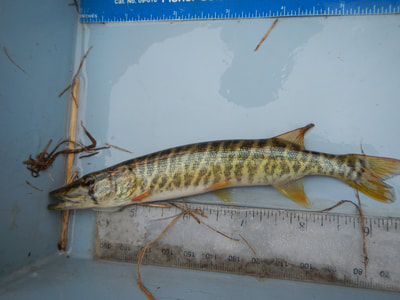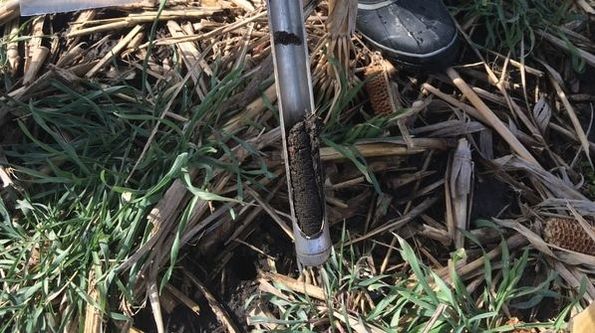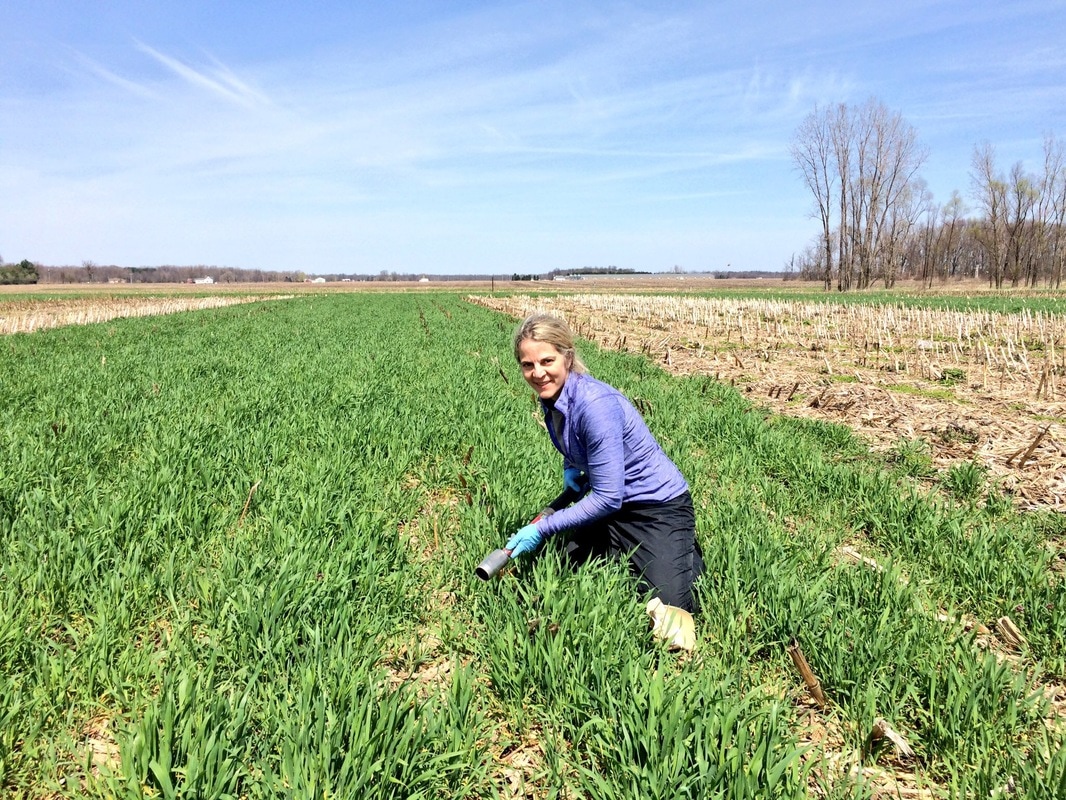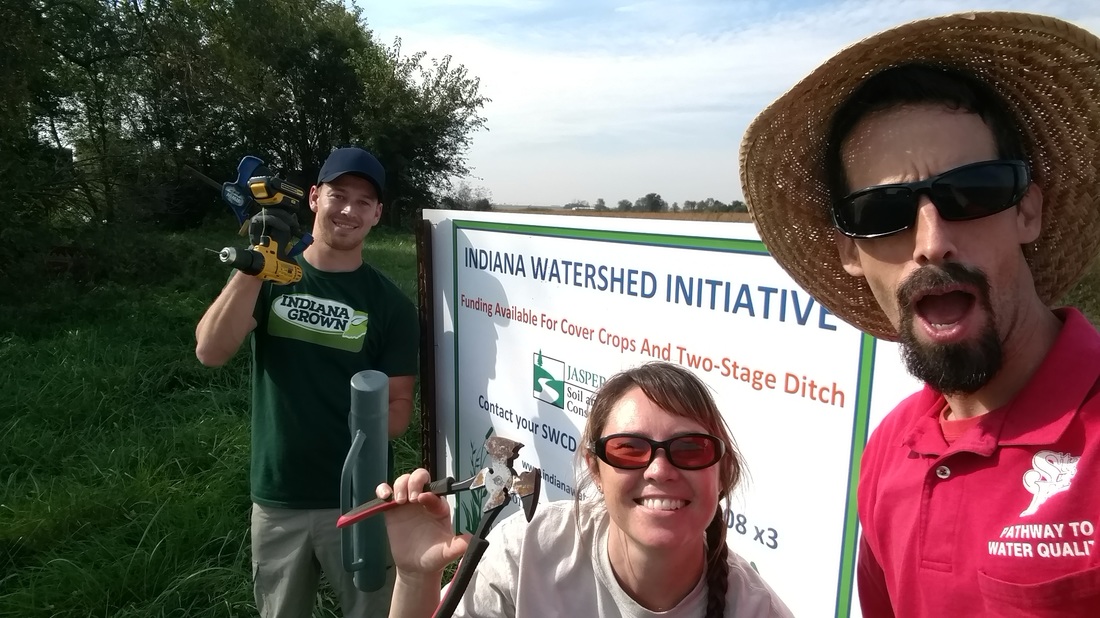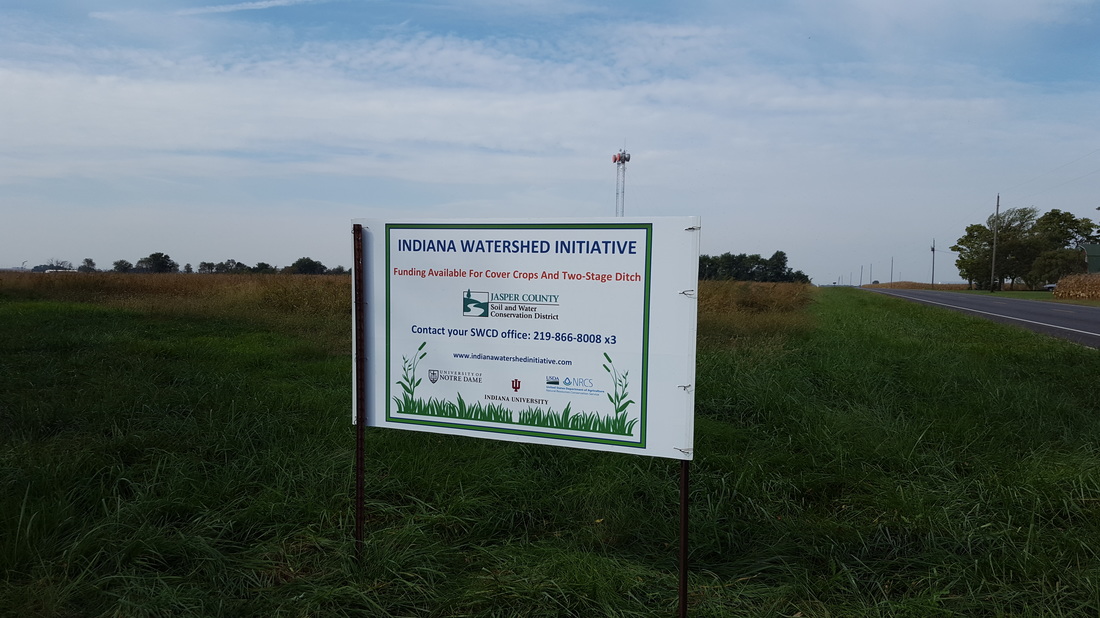Latest News
A new kind of data collection - fish surveys, July 2017
A key indicator of a habitat's health is the flora and fauna supported there. We mostly focus on the quality of the water itself when working in our study streams but this summer we've added a new form of data collection - electro-fishing surveys. This is the best way to get an accurate snapshot of the fish population in a stream. An electric wave is sent through the water, temporarily stunning fish and allowing them to be collected for identification and measurement before being released again. Collecting this data will help us compare with historic records and future surveys to see how the fish community is changing over time.
Matt was joined in the field by Katie O'Reilly and Whitney Conard, fellow PhD students who study fish and aquatic ecosystems, meaning that their help was invaluable! Surveying Shatto Ditch at the end of July, they found a pretty diverse fish community including creek chub (Semotilus atromaculatus), mottled sculpin (Cottus bairdii), several different darter and dace species, grass pickerel and even green sunfish (Lepomis cyanellus).
Photo credits to Katie O'Reilly. Clockwise from top-left: Katie, Matt and Ameila using the gear to stun and net the fish; fish measurement; Katie modeling the gear; green sunfish; rainbow darter; grass pikerel.
Photo credits to Katie O'Reilly. Clockwise from top-left: Katie, Matt and Ameila using the gear to stun and net the fish; fish measurement; Katie modeling the gear; green sunfish; rainbow darter; grass pikerel.
Conference Season, June 2017
In June the research team took time away from the field and the lab, travelling in different directions to share results of the project to date. Beginning in North Carolina at the Society for Freshwater Science annual meeting, Jen, Brittany, Shannon and former research assistant Anna all gave talks on different aspects of the project including the impact of storms on nitrate fluctuations in our study streams and the impact of the long-established two-stage on benthic habitat in Shatto Ditch.
|
Then, at the Universities Council On Water Resources annual conference in Colorado, Jen chaired a special session on “Quantifying water quality outcomes of watershed-scale conservation projects” in which all four of our grad students and Tank Lab manager Ursula presented on their particular parts of the project research.
Meanwhile, co-PI Sheila presented soils data at the Society of Wetland Scientists annual meeting in Puerto Rico and, closer to home, Lizzie attended the Indiana Water Resources Association symposium at Turkey Run State Park, Indiana. It’s really important that we present preliminary data and seek feedback which helps us keep improving on our research methods. And, of course, hearing about the work of other projects gives us new inspiration and ideas! |
Watch this space for upcoming, peer-reviewed publication of some of our project data!
Meet the expanded research team, May 2017In May the whole research team met together in person for the first time and had a really productive time catching each other up on the latest data and making future plans.
The newest members of the team are John Tyndall and Adriana Valcu-Lisman of Iowa State University, who we are pleased to have on board to drive forward the economic analysis part of the project. John is Associate Professor of Natural Resource Economics and Adriana is a Post-Doctoral Research Associate in the Department of Economics. Their leadership will allow us to work on quantifying the economic benefits for both farmers and the environment of the watershed-scale implementation pairing cover crops with the two-stage ditch. The economic analysis will provide much-needed information about the actual costs and benefits to farmers. We're really keen to get them some hard figures to help them understand the impact of the conservation practices they are using. The team met up at Notre Dame and hosted seminars for the wider community where both John and Adriana presented their research. And we had a couple of great evenings out too! |
Sunny soil sampling days, Spring 2017The team have been out in March and April 2017 to carry out soil sampling before the termination of cover crops, which farmers will be doing soon in preparation for planting this year's cash crops. We use soil corers to take samples along multiple transects in a set of fields that we return to each sampling season in each watershed. Some had cover crops planted last Fall and some did not, allowing us to compare trends in soil properties over time. It takes a while to work through all that soil so results will be forthcoming later this year!
|
New signs erected to raise awareness of the IWI project, Fall 2016
Team members at the Soil and Water Conservation Districts (SWCDs) that cover the Kirkpatrick Ditch study watershed have been busy putting up new signs to raise awareness of our project. There are now two large road-side signs in Jasper County and one each in Benton and Newton counties which give the relevant SWCD contact information so that interested landowners can get in touch to ask about the cost-share funding available for cover crop planting and two-stage ditch creation.
Graduate student Matt Trentman presents at National Non-Point Source Pollution Workshop, August 2016At the National NPS Pollution workshop in Salt Lake City, Matt gave a presentation on our research into the effectiveness of the two-stage ditch at reducing nutrient export and turbidity, as well as reporting on current work looking at the effectiveness of winter cover crops to reduce watershed-scale nutrient export. He also described the goals and future work planned for the IWI project.
During the meeting, the group was fortunate enough to meet a rural Utah farmer (in the cowboy hat, right) who enthusiastically showed off the stream restoration project on his property. He explained that after initially being wary of working with the federal government, he was very happy with his new collaboration with Utah NRCS and the local SWCD team. Matt found his story very inspiring and it was great to hear about another project, like our IWI project albeit in a different setting, where genuine partnerships bring about great results for farmers and the environment! Overall, this workshop was a fantastic opportunity to showcase our work further afield and also learn about the challenges and solutions to managing stream erosion and nutrient issues in a setting completely different to our northern Indiana sites. |
Team presents project results at Indiana Water Resources Association symposium, June 2016Four of our team members attended the IWRA symposium in Angola, IN, and gave a presentation to fellow scientists and members of water resources agencies about the impacts of cover crops on reducing nutrient loss from our demonstration watersheds.
|



